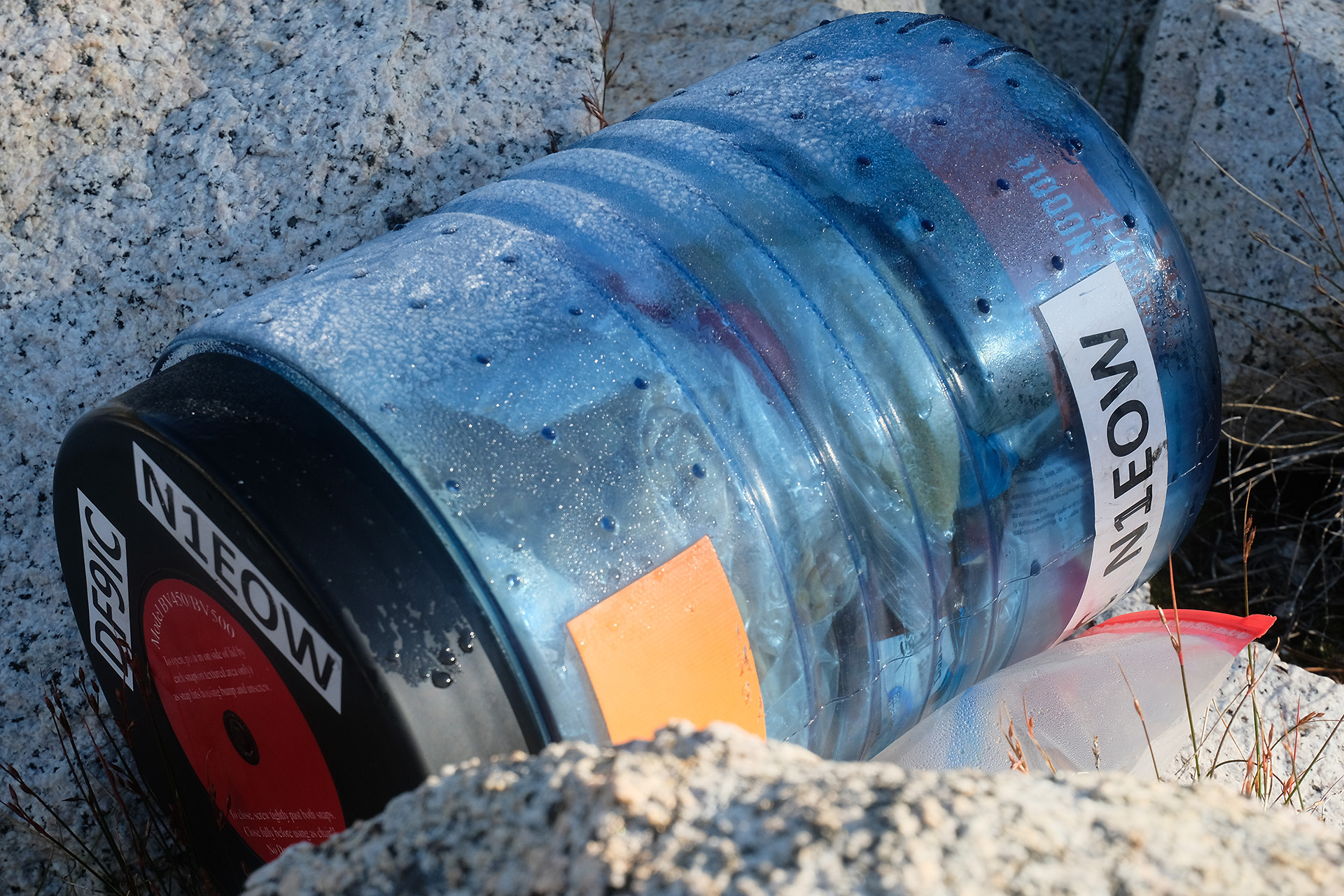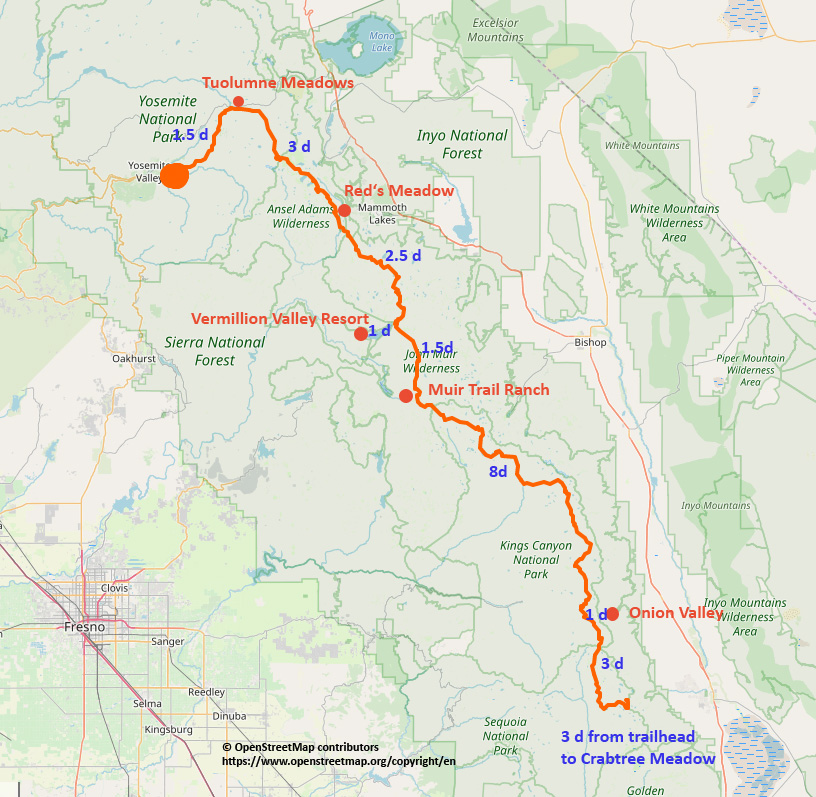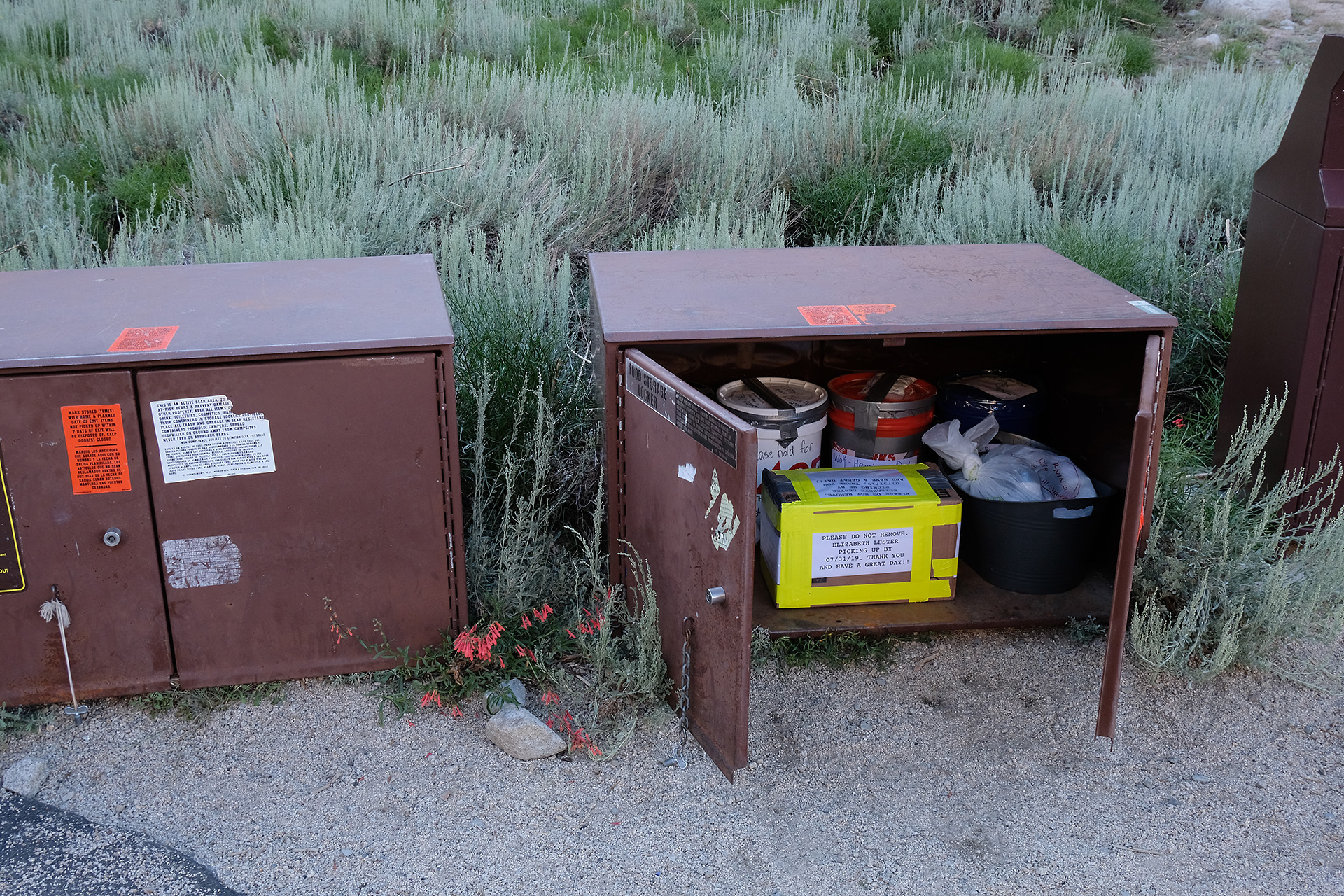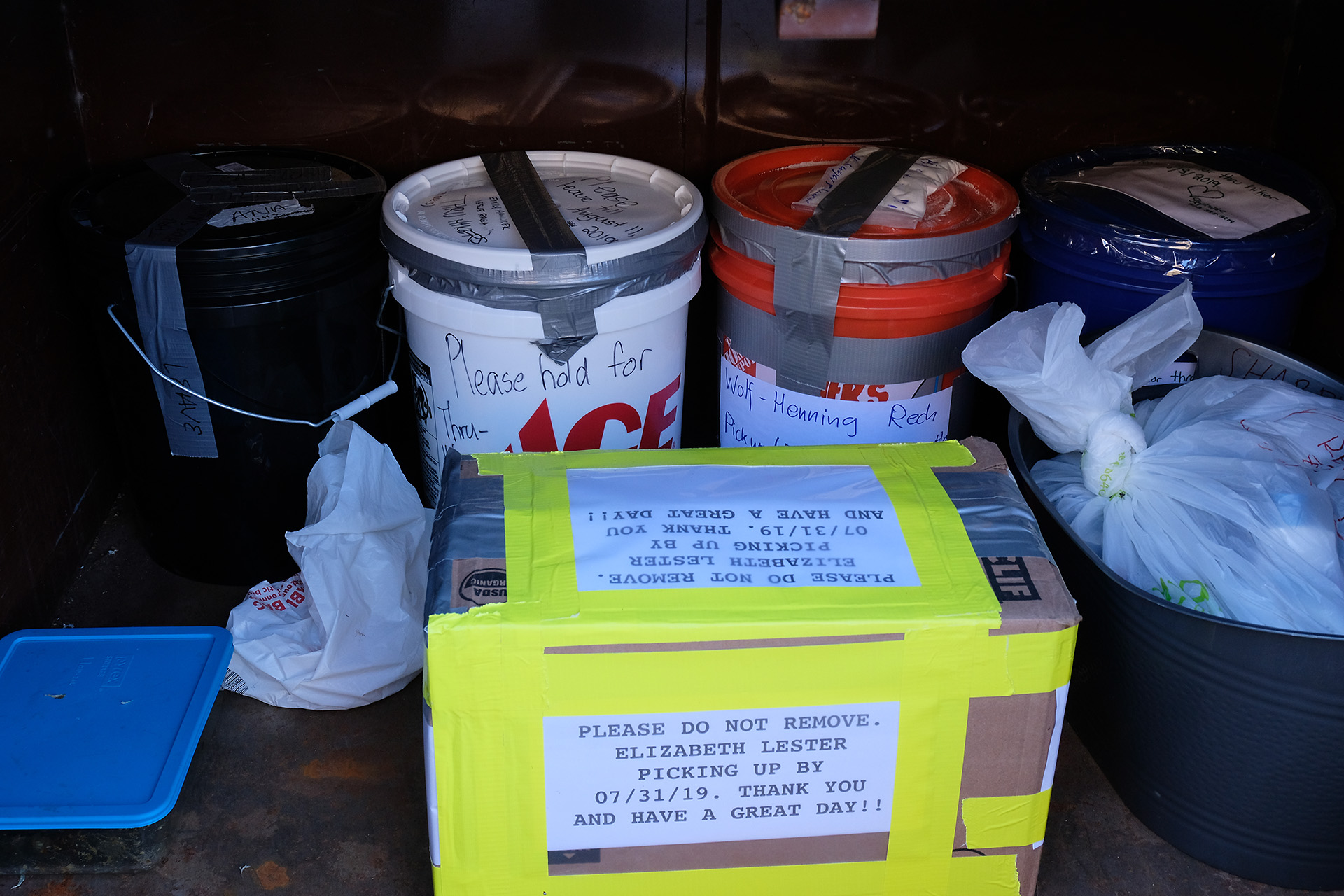The remoteness of the John Muir trail, which accounts to a big part for its charm, forces the hiker to think about supply of food and other consumables.
The amount of food that can reasonably be carried is limited both by its weight and the volume of the bear can where it should fit into. So volumetric and caloric density is important. It must also be storable for a few weeks at higher environmental temperatures, and last but not least, should taste.
I carried a BearVault BV500 canister (11.5 l volume) which is sufficent for 6…9 days of food. You are allowed to carry the food for same-day use in your pack outside the bear can. Other smellables like toothpaste or hand sanitizer I stored elsewhere.

The JMT has only limited resupply options. The map shows their location and the time I needed for the stretches between them, at a 24.5 day schedule from Horseshoe Meadow campground until Happy Isles. The line in the map represents only the classical JMT, one has to add 25 miles in the south for the approach trail.

The northern part offers 4 possible resupply locations:
-
- Tuolumne Meadows Post Office and General Store
- Red’s Meadow General Store
- Vermillion Valley Resort (VVR) General Store
- Muir Trail Ranch (MTR)
There are two different ways to resupply: buy on site or ship a resupply bucket per mail. While it is often cheaper to use the stores on site on the long distance trails like the PCT, the Sierra section, i. e. the JMT, has only limited selection and amount of food in those remote stores. So you better ship. “Hiker boxes” at these locations allow you to leave unneeded items for others who may need them, and vice versa complement your own supply out of them.
Tuolumne Meadows: it is a normal PO which offers General Delivery Service. But you have to watch its limited opening hours, which include closure during Saturday afternoon and Sunday. They charge no extra fee for handling your resupply. There is also a reasonably stuffed store. The Tuolume Meadows General Store and Post office are located together directly at the Hwy 120 where most JMT hikers pass.
Red’s Meadow Resort: the resupply buckets are held in a special room aside of the General Store and can be claimed daily during its opening hours with immediate access. The resort charges a handling fee (40$ in 2019). The bucket should be sent with USPS. The store has a good selection of food. The Red’s Meadow Resort is about 0.5 miles off the trail.
VVR: the resupply buckets are held in storage rooms somewhere on the premises. They can be claimed daily when the staff has time, and may need some time to arrive at the store for pickup. The resort charges a handling fee (30$ in 2019). The bucket should be sent with UPS (not USPS). The store has some food and other goods. VVR can be reached either by hiking 1.5 miles off the trail and then use the water taxi running each once in the morning and afternoon (23$ two-way in 2019) or by walking along the lake a total of 6 miles.
MTR: the resupply buckets are held in a storage room. They can be claimed daily during limited opening hours (9 am-5 pm). Only guests are allowed to stay on the ranch outside these opening hours. The resort charges a high handling fee (80$ in 2019). The bucket should be sent with USPS early as it is delivered only once per week by a mule train; MTR recommends to ship it 3 weeks in advance. There is also a very small store where you can buy gas cartridges but nearly no food. The hiker boxes are well maintained and often full of goodies. MTR is about 1 mile off the trail.
The southern part of the JMT is the real challenge for resupply. There is no facility close to the trail so you have either to walk fast without any resupply, or hike out somewhere. Most hikers go over the Kearsarge Pass into the Onion Valley until the trailhead and parking lot. Then there are multiple options:
-
- hitchhike from the parking lot to the village of Independence (500 residents) and use its PO for resupply, then stay at one of the motels and return the next morning; cost of motel room
- use the resupply package of Mt. Williamson motel inluding shuttle service from the parking lot and overnight accommodation, laundry etc.; 190$ in 2019
- send your resupply to Berners’ Pack Outfits located directly at the parking lot and claim it there; 70$ handling fee in 2019
- put your resupply bucket yourself into a bear box at the parking lot before your hike if you have the time; mark it with your name and ETA; no extra cost; easier for NoBo hikers
You can instead send your resupply to Berners’ Pack Outfits and rent a pack mule to let ship it up to the trail; about 600$ in 2019; then you save the extra day for the hike-out.
Some of above options commit you to be on a certain place at a certain time/date which will not always work as planned, and then may cause hazzle.
Edit: from 2020 a wildernis permit for the JMT will no more allow to leave the wildernis which means that going beyond Onion Valley trailhead will terminate your permit. So only a resupply at the parking lot is considered legal within your JMT permit. A resupply in the town may be tolerated as long as you do not stay overnight. Ask the rangers.
My approach:
I used three resupplies: Onion Valley, VVR and Red’s Meadow Resort.
For Onion Valley I put my bucket into a bear box the day before my start. I also stayed this night at the campground (20$) for better height accomodation (9.000 ft). A week later I went down and up again on a single day.
I prefered VVR over MTR because of the longer time for my bucket to arrive there (2 days later) together with faster transport (UPS and 4WD car instead of USPS and mule train). And I saved some handling charge and had more fun there for the same money. I kept the option to go down to MTR and have there a small resupply out of their hiker box if I would run short of food, but did not have to use this option.
The Red’s Meadow stop was not necessary retrospectively, I could have walked from VVR to Happy Isles without another resupply. It would have allowed me at least a more flexible timing if I had advanced faster and wanted to insert zero days, and made the pack more lightweight after VVR.
I had dinner and breakfast at VVR, and kind of late lunch / early dinner both at Red’s and Tuolumne Meadow. This helps to add some food you do not have to carry.
I put a gas cartridge in the Onion Valley resupply (only allowed if not shipped by mail) and bought another one in the store at VVR. I had batteries for the headlamp both in the Onion Valley and VVR resupply.
If you want to resupply at MTR as an international hiker you may not be able to ship your bucket in time; but you can use a resupply service, e. g. Zero Day Resupply, which sends the food ordered out of their catalogue early enough to MTR before yourself arrive in the US.


The preferred container for food resupply is a 5 gallon bucket with lid. It is safe against critters, mice etc, and can be shipped by USPS and UPS as is. Just fix the lid with duct tape and remove the handle. Watch the instructions of the resorts about the location of name tags. I used the orange bucket from Home Depot (<10$ with lid) for all my resupplies and had no issues.
Selection of food is individual. You cannot import most home-made menus like self-dehydrated food into the US so you must buy most of your food there. In addition I had 2 kg granola mix with fruits, 900 g Nestle Nido powdered milk, and about 4 kg of protein bars (3 x 45 g per day) with me. You should bring such food in their original unopened package, and partition it into ziplock bags in the US only.
For dinner I often used the Mountain House brand menus which were ok but not stellar, compared to their expensive price tag. I tried another brand once but did not like it at all. I also had couscous and tuna, and would have liked to have potato mash as another base food, also dried onions and vegetables. Cashews and jerky were used both for snacks during the day and sometimes added to the dinner, together with olive oil for more fat. BabyBel mini cheese balls survive the heat more or less and were still eatable after 3 weeks. Ramen noodles and mac’n’cheese need much volume compared to their calories so I had them only once each. Everything you want to eat hot should not need real cooking but just rehydration in hot water, to save gas and keep the pot cleaner.
My beverages apart from pure water were hot tea in the morning, a hydration mix sometimes at noon or in the late afternoon, and a “Swiss Miss” hot cocoa drink sometimes before dinner. I would have liked to have more electrolytes, here some nutritional supplements really make sense.
I needed about 4-5 l of water daily for food and beverages: nearly 2 l for dinner and breakfast, and the rest on the hike. But I always drink a lot, so your mileage may vary – mine seems to be no more than 10 miles per gallon…
I was never hungry and ate less than expected, lost lots of weight on the trail. I had to readjust the hip belt of my backpack nearly daily, but was quite happy about this.